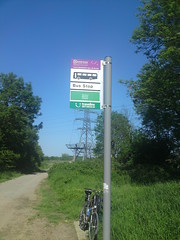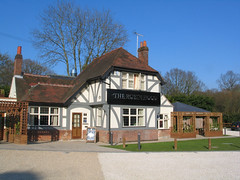After Mark Iliffe & I met at State of the Map 2010 in Girona, we talked about arranging an event for OSM contributors in the East Midlands to meet-up. As Mark was then Leicester-based we'd been thinking of a mapping party. However, with Mark doing a PhD in Nottingham it seemed that we could start with something a little less formal. A pub meeting seemed a good chance to meet some fellow mappers face-to-face and talk about the activities which interested people.
At the outset I hoped we might at get at least five people, that I'd get to meet another local mapper, and that we'd make contact with other interested parties.
I was immediately reassured when I saw that Shaun was coming. Neatly, he was my first ever OSM contact point when I first attended a London pub meeting almost exactly two years ago. Joining us were: local mappers Andy (SomeoneElse), Kev (kevjs1982) and Laura; David came along representing Pedals, the local cycle advocacy group; and Marcus came from Nottinghack, the Nottingham Hackspace. So 8 of us altogether was a nice turnout. It was nice to make contact with Pedals, and a wonderful surprise to discover about the hackspace.
Subjects which came up in the course of the evening:
- Inability of the automated voice in Garmin nuvi to cope with "Huthwaite".
- DINTY, monads, tetrads and octads (dont ask).
 The lonely bus stop on Erewash Field (see image at right, discovered by Kev)
The lonely bus stop on Erewash Field (see image at right, discovered by Kev)- Differences between Lancashire towns with lots of rows of terraced housing and Nottingham's huge legacy of inter-war ditto
- Co-ordinating mapping activity, specifically for crisis mapping. I alluded to the difficulties involved, and the general point that usually mapping activity tends to self-correct. Mappers are both ants (self-organising) and cats (not easy to herd).
- Pubs which have gone (The Gate at Jacksdale).
- Marcus asked why the map round the Borlase Warren had lots of buildings but few Points of Interest. We agreed that adding individual shops was surprising labour intensive and error prone. Kev, who has mapped all the shops on Central Avenue, West Bridgford, said it was pretty easy to accidentally miss one. (Also, I had surveyed these but have not added them to the map).
- David asked the active mappers if we ever used OSM. He got an emphatic yes, Andy showing that his Garmin showed pubs with a real_ale=yes tag.
A straw poll suggested that we should do it again, and so I'll be scheduling a date for April real soon now.
Any OpenStreetMap is, of course, an opportunity to add to the map, so I'm glad to report, that after an extensive survey, Andy (SomeoneElse) summarised our conclusions.
PS. I went to Nottinghack's weekly opening evening the following day and was able to add them to OSM.











